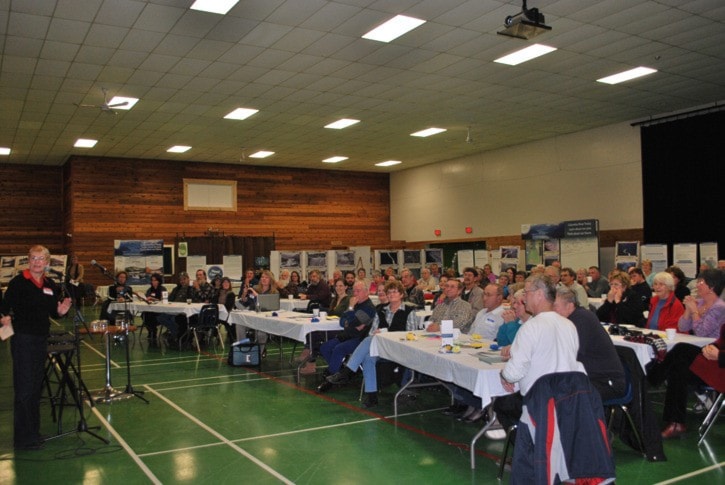With hockey practise as well as the Columbia River Treaty (CRT) information session taking place that night, the parking lot at the Nakusp Arena was completely full November 15.
People curious about the Treaty were greeted at the door by Columbia Basin Trust staff, who encouraged them to fill out a quiz card about the CRT as a draw for door prizes. Arranged through half the auditorium, large pictures displayed the history of the Basin, some from before the flooding and some afterward. Photographs of people and places who were part of life along the waterways shared space with interactive areas that asked participants for their views and questions about the CRT both in the past and present.
More than 100 area residents filled the auditorium, a record turnout, per capita, for the sessions so far.
Early attendees were first treated to a spaghetti dinner at 6 p.m., then a condensed presentation that outlined the main points of the CRT, its history and its possible future, began at 7 p.m.
Right off the top, both Ron Oszust and Kindy Gosal from the CBT spoke to the history of the flooding of the Columbia Basin. Gosal articulated that the presentation came to each community with humility, particularly to Nakusp and Jaffray, two areas very affected by the CRT, and with the understanding that there was a deep hurt just below the surface. Gosal also pointed out that the past can’t be changed, and that the purpose of the CBT was to work with people now in order to build a better future.
Local historians Milton and Rosemarie Parent were singled out by local CBT employee Lynda Lafleur in recognition for all their contributions to the displays as well as their efforts and achievements in our community.
Participants were next treated to a very short film that outlined the major points of the CRT. In only a few minutes, the complex document was summarized to a few succinct points.
The audience learned that the CRT, which was ratified in 1964, coordinates flood control and hydroelectric energy benefits between the U.S. and Canada. Even though it is an international treaty, due to an agreement between Canada and B.C., the province is responsible for determining where the treaty will go.
In terms of energy benefits, the U.S. pays 50 per cent of the estimated increase in downstream power benefits (determined from the amount of power it is possible to generate in a given year, not the amount actually produced) to Canada; this is called the Canadian Entitlement. The U.S. now pays an annual Canadian Entitlement in the order of $150 to $300 million a year.
When the CRT was signed, the U.S. also paid $64.4 million for flood control for the first 60 years of the treaty; this period comes to an end in 2024. Because of the CRT, this Assured Annual Flood Control is guaranteed until 2024. Another type of flood control outlined in the CRT, On Call Flood Control, is designed to be used during periods of very high inflows. To date, this kind flood control has never been used and it is therefore unknown how it would work as a mechanism for flood control.
Although the treaty is an evergreen agreement, which means it has no expiration date, either country can decide to withdraw from the treaty after 2024, but must give a minimum of ten years’ notice.
There are three options facing the two countries with respect to the CRT. The treaty can continue as it is, with no replacement agreement, which would mean the Canadian Entitlement and flood control remain the same. Another option is to have the treaty continue, with Canada continuing to receive downstream power benefits but flood control switching from Assured Annual to On Call. The third possibility is for the treaty to be terminated, with downstream benefits no longer being paid out and Canada no longer required to control flow for U.S. power interests. Under this scenario, flood control would also change to On Call.
After the pithy presentation ended, the lights came back up and participants were called upon to gather into groups and come up with questions about the CRT.
In response to the first question about compensation for the loss of arable land, Kindy Gosal remarked that this was an issue brought up at every info session. He also said the loss of the land was the driving force behind the development of the CBT, which people may not see as fair, but it was one of the mechanisms for compensation in the Basin, along with the land deals made at the time and the creation of the Fish and Wildlife Compensation Program.
Ken Hall, an environmental chemist, pointed to the potential for the CRT to be changed in ways that can reflect the gains in knowledge and technology in the last 50 years. As an example, he mentioned the possibility now of “fish flows,” a way of letting fish through dams that wasn’t an option previously.
When the question about what the benefits of each of the treaty options were, Kathy Eichenberger from the Ministry of Energy and Mines said that was exactly what they were researching now. Her hope is to return to the communities in May or June of next year in order to present their findings and gather input from people in order to formulate recommendations to take to cabinet in November 2013. At the moment, weekly meetings are held between organizations on both sides of the border to ensure close communication and collaboration in advance of the 2024 end date.
At the very end of the evening, the presenters and organizers thanked everyone for coming out, and people slowly drifted out to their vehicles in the parking lot. For the organizers, the night wasn’t over, and all hands helped break down and load up the displays, tables and equipment in preparation for the next town along their Columbia Basin info tour.
